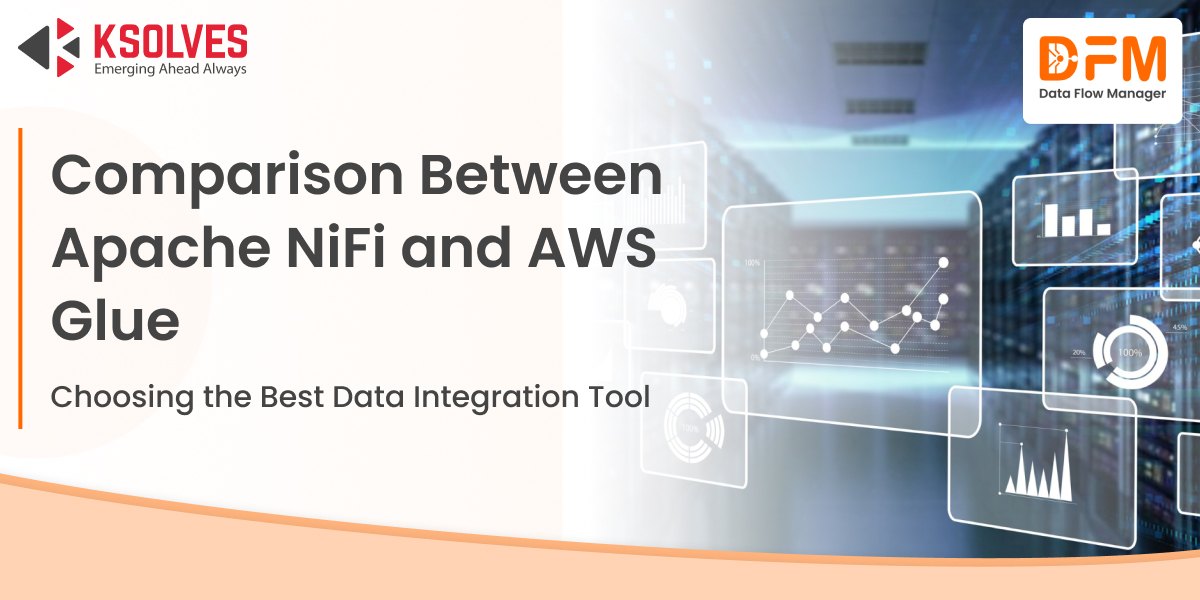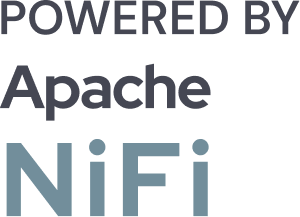Apache NiFi vs AWS Glue: Which is Better for Data Integration?
![]()

As data has become the new oil, organizations are increasingly relying on automated tools to move, transform, and manage massive volumes of data. The choice of data integration tool can significantly impact performance, scalability, and cost-efficiency.
Among the leading contenders are Apache NiFi, known for its real-time processing and flexibility, and AWS Glue, a cloud-native, serverless platform from Amazon Web Services designed for large-scale ETL workflows.
This comprehensive guide compares NiFi and Glue across all essential parameters to help you choose the right fit for your business goals and technical infrastructure.
Apache NiFi: Flow-Based Programming for Real-Time Data
Apache NiFi is an open-source, user-friendly data automation tool built for real-time data ingestion and transformation. It uses a flow-based programming model to help teams design, monitor, and control complex data workflows, from edge devices to enterprise data lakes.
Key strengths include its drag-and-drop UI, support for diverse protocols, detailed data lineage, and strong customization through custom processors.
AWS Glue: Serverless ETL for the Cloud-Native Enterprise
AWS Glue is a fully managed, serverless ETL (Extract, Transform, Load) service offered by AWS. Designed to simplify the process of data preparation for analytics and machine learning, Glue automates much of the infrastructure work, allowing developers and analysts to focus on business logic and transformations.
It excels in scalability, deep AWS integration, and automation through its built-in Data Catalog and Spark-based job execution.
Apache NiFi vs AWS Glue – Exploring the Key Differences
| Parameter | Apache NiFi | AWS Glue |
| Deployment Model | Open-source and self-hosted. Can be deployed on-premises, in the cloud, or in hybrid environments. | Fully managed, serverless service hosted within AWS. |
| Integration Capabilities | Supports protocols like HTTP, FTP, Kafka, MQTT, SFTP, and AMQP. Highly extensible and format-agnostic. | Deep integration with AWS services like S3, Redshift, RDS, and Athena. Limited support for non-AWS services and on-premises connectors. |
| Data Ingestion | Real-time and batch ingestion from databases, APIs, cloud apps, IoT devices, logs, and messaging systems. | Batch ingestion, suitable for periodic ETL jobs. Integrates well with AWS data lakes and S3 buckets. |
| User Interface | Drag-and-drop web-based UI with detailed flow visualization and data provenance. | Primarily code-based (PySpark/Scala), with limited UI for job authoring and pipeline orchestration. |
| Scalability | Manual cluster scaling and resource management. Can scale horizontally by adding nodes. | Auto-scaling serverless model. Resources are provisioned on demand based on workload. |
| Security Features | Built-in support for SSL/TLS, LDAP, Kerberos, multi-tenancy, RBAC, and data-level security. | Integrated with AWS IAM, VPC, KMS for encryption, and other AWS-native security features. |
| Customization & Extensibility | Highly customizable via custom processors and scripting. Suitable for unique routing or transformation logic. | Limited to what’s supported in AWS Glue ETL scripts. Extending functionality requires deep AWS knowledge and scripting. |
| Monitoring & Management | Full data lineage and provenance tracking, built-in back pressure controls, alerts, and stats. | Job status monitoring, CloudWatch integration for alerts and logging. Less granular visibility than NiFi. |
| Pricing | Free and open-source. Operational costs depend on infrastructure, scaling, and maintenance. | Pay-as-you-go pricing based on Data Processing Units (DPUs), job run time, and catalog usage. |
Apache NiFi vs AWS Glue – Standout Features
Features of Apache NiFi
- Intuitive Flow Design: Easily map data movement visually without writing code.
- Real-Time + Batch Flexibility: Choose between event-driven or scheduled workflows.
- Protocol Agnostic: Works across multiple formats and network protocols.
- Custom Processors: Build your own logic for routing, transformation, and enrichment.
- Flow Prioritization and Back Pressure: Prevent overload and manage system stability.
- Built-In Data Lineage: Trace every step of your data for compliance and debugging.
Features of AWS Glue
- No Infrastructure Setup: Simply configure and launch – AWS handles scaling and provisioning.
- Deep AWS Ecosystem Integration: Glue works seamlessly with S3, Athena, Redshift, and more.
- Job Scheduling & Automation: Trigger workflows based on time or events.
- Data Catalog: Automatically maintains schema and metadata across sources.
- Support for PySpark & Scala: Build rich, scalable transformation logic.
- Serverless by Nature: Scale ETL workloads without managing compute clusters.
Pros and Cons of Apache NiFi and AWS
Pros of Apache NiFi
- Powerful for real-time and event-driven data flows.
- Fully customizable and protocol-flexible.
- A visual interface simplifies complex logic.
- Ideal for hybrid and on-premise deployments.
Cons of Apache NiFi
- Requires operational overhead and infrastructure management.
- Performance tuning is needed for high throughput.
- Smaller user community and steeper learning curve for beginners.
Pros of AWS Glue
- No infrastructure to manage; it’s fully serverless.
- Deep integration with AWS analytics and storage services.
- Automatically scales and supports schema evolution.
- Efficient for batch ETL workloads with a built-in job scheduler.
Cons of AWS Glue
- Limited support for real-time or streaming workflows.
- Requires coding knowledge (PySpark/Scala) for complex jobs.
- Best suited for AWS-native data pipelines; limited cross-cloud flexibility.
Apache NiFi vs AWS Glue – Use Cases
Apache NiFi Use Cases
- IoT and Edge Data Ingestion: Real-time collection and processing of sensor data.
- Log and Event Monitoring: Capture and analyze log streams in real time.
- Hybrid Cloud Data Routing: Move data between on-premises systems and the cloud.
- ETL with Fine-Grained Control: Build complex routing, filtering, and enrichment pipelines.
AWS Glue Use Cases
- Data Lake ETL: Prepare and clean data in S3 for use in analytics or ML.
- Data Warehouse Loading: Transform and load data into Redshift or Athena.
- Metadata Cataloging: Maintain a central catalog of schema and data assets.
- Scheduled Batch Pipelines: Run ETL workflows at fixed intervals or upon trigger events.
Which is Better: Apache NiFi or AWS Glue?
The right choice between Apache NiFi and AWS Glue depends on your use case, infrastructure, and team capabilities:
Choose Apache NiFi if:
- You need real-time streaming and control over data flows.
- You’re operating in a hybrid environment.
- You require custom processors and protocol diversity.
- You prefer a self-managed, open-source solution.
However, manually deploying NiFi data flows is still complex, leading to operational inefficiencies and overhead.
Data Flow Manager emerges as a go-to solution for seamless NiFi data flow deployment and promotion. It eliminates the need for using NiFi UI, controller services, and hours of manual scripting. With version control & rollback, role-based access control, and an AI-powered flow creation assistant, Data Flow Manager enhances NiFi’s operational agility while reducing costs by up to 70%.
Choose AWS Glue if:
- Your data infrastructure is cloud-native on AWS.
- You’re dealing with batch ETL or building data lakes.
- You want a fully managed, serverless solution.
- You need tight integration with other AWS services.
Conclusion
There’s no one-size-fits-all data integration tool — it’s about aligning the tool with your technical needs and data strategy.
Apache NiFi is your go-to for customizable, real-time, and hybrid data workflows.
AWS Glue is perfect for scalable, code-driven, and cloud-native data integration within the AWS ecosystem.
Evaluate your latency needs, infrastructure model, and desired level of control — and choose the platform that moves you from data complexity to clarity.
![]()

